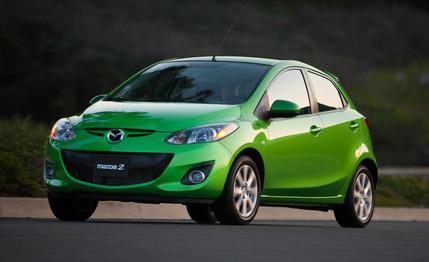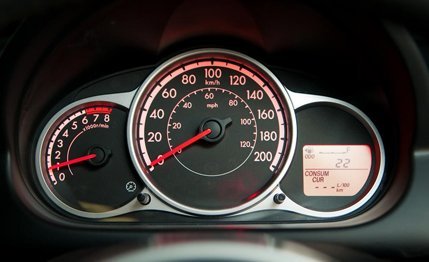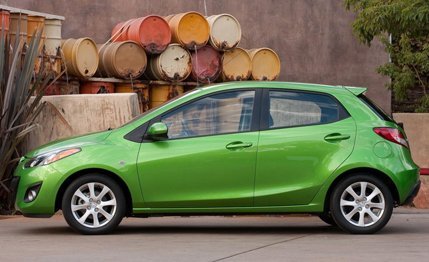
 Short Take Road Test
Short Take Road Test


It’s a poorly kept secret that small economy cars are more fun than high-performance cars to drive on the street since they can be used to their full potential. You can floor the gas pedal at every stoplight without getting arrested and slide around an on-ramp at subillegal speeds.
Of course, beating on a cheap car doesn’t eclipse the thrill of a sub-12-second quarter-mile or pulling high g in a corner, but entry-level cars ask little and give everything they have in return. It’s like the Budweiser ad where the Dalmatian wishes it were a Clydesdale, except replace the Dalmatian with a Jack Russell terrier and the Clydesdale with a sports car. Voilà—the perfect (mixed) metaphor for the Mazda 2. Has any car since the original Plymouth/Dodge Neon looked so plucky? Nobody will mistake the Mazda 2 for anything remotely premium—its diminutive size (21.9 inches shorter than the Mazda 3 five-door) and 15-inch wheels make sure of that—but the big headlights and the smiling grille give the 2 a face that just begs you take it out and play.
You Win Some…
The interior of the Mazda 2 can’t shake the economy-car vibes, either, but it does a decent impersonation of a car that costs a few dollars more. Our test car was a Touring model, which gets a leather-wrapped steering wheel, red accents on the fabric seats, and steering-wheel-mounted controls for the radio and cruise control, all of which contribute to an upmarket feel. (The Touring also adds alloy wheels, fog lamps, a rear spoiler, and a chrome exhaust tip.) That upmarket feel, sadly, doesn’t extend to the cheap-looking headliner and even cheaper vinyl sun visors (with vanity mirrors), and there are no individual map lights. For those turned off by the lack of an armrest, though, be comforted by the knowledge that one will be available as a port-installed option early next year.


The lack of an armrest would be less of a problem if our test car had come equipped with a manual, giving us more to do with our right hand, but this time our 2 runs its power through a four-speed automatic transmission. The automatic costs $800 more than the standard five-speed manual, and if you can shift for yourself, you’re better off saving the money as well as a few seconds running from stoplight to stoplight. This test car covered 0 to 60 mph in 10.2 seconds—within 0.3 second of an automatic Honda Fit—and leisurely strolled through the quarter-mile in 17.9 seconds at 77 mph. When there are only 100 horses’ worth of motivation, as the Mazda 2 gets from its 1.5-liter inline-four, you need to make the most of it all, and the automatic just can’t, especially as you travel near or at highway speeds. Going beyond those velocities, the top speed of 103 mph actually is achieved in third gear (an “O/D off” button forces the transmission to hold third); we could only muster 101 mph in fourth. We tested a Mazda 2 with the five-speed manual for an upcoming comparison test, and it was not only quicker (0 to 60 mph in 9.1 seconds) but far more satisfying to drive.
Still Fun No Matter How You Slice It
Slushbox notwithstanding, the Mazda 2 is pure driving fun. One reason is the light, 2341-pound curb weight, which helps keep the handling lively and the skinny 185/55 tires from being overwhelmed. It’s a car that’s fun to toss around, and like all econoboxes, you can do so in the 2 at speeds where you still have room for error. If you screw up, the handling defaults to reassuring understeer, although a gentle tail wag is possible in corners with an abrupt lift of the throttle. In those regards, this little hatch acts like a front-wheel-drive Miata. Of course, the 2 is different from a Miata in pretty much every other way, most of all in its fixed roof, two extra rear doors, and three additional seats. The 2’s back seat is a little short on headroom, and there’s no center headrest, but a couple of kids or small adults will fit fine. Behind that is a 13-cubic-foot cargo area that expands to 28 cubic feet with the seats folded.
The Mazda 2’s EPA ratings say to expect 28 mpg city and 34 highway (35 with the manual), and the lead feet in our office achieved 28 mpg, partly as a function of constantly flooring the throttle to get the automatic to downshift and put the engine in a more usable rev range. (We saw 33 mpg from the manual-equipped 2, although it saw a lot more highway driving.)


The 2’s price is nice, starting at $14,730, and our test example rang in at $16,985. As for the competition, the Ford Fiesta hatchback starts at $15,795, the cheapest Honda Fit is $15,650, and the Nissan Versa five-door can be had for as low as $14,270. But add options to those models to equip them comparably to the 2, and their prices zoom past this Mazda’s; we stand behind our conviction that it represents a good value. Besides, the 2’s lively handling makes it among the most rewarding to drive of the bunch, even though it loses in cargo versatility to the Rube Goldbergian Fit. If you want to keep the price down, though, the Mazda 2 Sport should drive exactly the same as this Touring, and it still has features like A/C, power windows and locks, and keyless entry as standard. In either guise, the 2 provides clear proof of that secret we mentioned up top: Small, cheap cars can deliver ample fun during everyday driving, and they don’t come much more enjoyable than the Mazda 2.